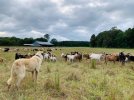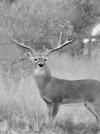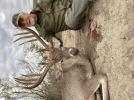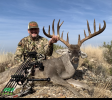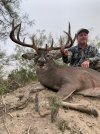Certainly, but first a big picture overview. I'll try to be brief.
When I bought the ranch in the mid 90's I was very interested and inspired by the work of Allan Savory and intensive rotational grazing with its impact on soil ecology. I was going to introduce those practices at the ranch but it didn't take long to realize I didn't have the skills, attention or knowledge available to make it work especially in remote Mexico. But my interest never waned and evolved into research about regenerative ag and grazing. At the very deepest level I believe living vibrant soil holds the key to many of the issues we deal with as society today. { I'll spare you my wordy philosophical pontifications about that for now}
On my farm I began no till multi specie year round practices about 10-12 years ago and indeed have seen positive results. I eliminated synthetic fertilizers years ago, have never used pesticides, fungicides, RR crops and greatly reduced but not eliminated the use of gly. While there have been improvements being a restless soul I have not created what the vision is in my head. Then I ran across Dr. Allen Williams of Understanding Ag. Undergrad at Clemson. PHD at LSU, then taught at La. Tech in Ruston. The stars aligned and I knew I found the pathway forward.He's brilliant, very familiar with my ecosystems, works alll over the world deeply networked with all the right people.
I hired him to take my farm to the next level employing regenerative practices designed to light up the ecosystem . One of the first things he said was that I cannot reach my goals without animal impact. So a plan was created anticipating more cattle centric with silva culture grazing and using the cattle to terminate the plots spring and fall. Then hurricane Laura hit last year. While devastating , ugly and destroying a significant % of timber in retrospect it was a blessing in disguise. Just meant we needed to shift the 'tools' required to create the outcome we wanted. Hence goats! But directionally we will have goats, cows, sheep, laying hens, broilers, seasonal turkeys, organic market gardening, honey production,...and anything else we can stack as an enterprise. I want life to flourish on the farm! I'm turning this it into the 5th career in my life and candidly the one I'm most passionate about.
In August I hired a bright talented guy experienced in regenerative grazing plus experience in organic market gardening and challenged him to build the program from the ground up. He's on fire!
Now to answer your question. We graze/browse the goats no more than 4 days per paddock for reasons mentioned above using 3 strands of electric fencing. Last summer I brought a trac hoe in and created lanes for larger paddocks . We have rigged a Polaris with a jig to use plastic posts and string the wire. It hardly takes over an hour to create the paddock. The most time consuming chore is dividing the larger paddock into smaller ones which is unique to my farm because of all the downed trees. The goats take very little coaxing to move to a new paddock which 1 person can easily do. We have Buddy The Wonder Dog living with the goats and have had zero predation in spite of a healthy predator population.
The secret sauce to all this is intense short duration grazing with lengthy rest periods for each paddock . Observation is the key. There is a wealth of information about regenerative grazing on YouTube and at its basics easy to employ though daily attention valuable.
I could rant on more but enough for now......
When I bought the ranch in the mid 90's I was very interested and inspired by the work of Allan Savory and intensive rotational grazing with its impact on soil ecology. I was going to introduce those practices at the ranch but it didn't take long to realize I didn't have the skills, attention or knowledge available to make it work especially in remote Mexico. But my interest never waned and evolved into research about regenerative ag and grazing. At the very deepest level I believe living vibrant soil holds the key to many of the issues we deal with as society today. { I'll spare you my wordy philosophical pontifications about that for now}
On my farm I began no till multi specie year round practices about 10-12 years ago and indeed have seen positive results. I eliminated synthetic fertilizers years ago, have never used pesticides, fungicides, RR crops and greatly reduced but not eliminated the use of gly. While there have been improvements being a restless soul I have not created what the vision is in my head. Then I ran across Dr. Allen Williams of Understanding Ag. Undergrad at Clemson. PHD at LSU, then taught at La. Tech in Ruston. The stars aligned and I knew I found the pathway forward.He's brilliant, very familiar with my ecosystems, works alll over the world deeply networked with all the right people.
I hired him to take my farm to the next level employing regenerative practices designed to light up the ecosystem . One of the first things he said was that I cannot reach my goals without animal impact. So a plan was created anticipating more cattle centric with silva culture grazing and using the cattle to terminate the plots spring and fall. Then hurricane Laura hit last year. While devastating , ugly and destroying a significant % of timber in retrospect it was a blessing in disguise. Just meant we needed to shift the 'tools' required to create the outcome we wanted. Hence goats! But directionally we will have goats, cows, sheep, laying hens, broilers, seasonal turkeys, organic market gardening, honey production,...and anything else we can stack as an enterprise. I want life to flourish on the farm! I'm turning this it into the 5th career in my life and candidly the one I'm most passionate about.
In August I hired a bright talented guy experienced in regenerative grazing plus experience in organic market gardening and challenged him to build the program from the ground up. He's on fire!
Now to answer your question. We graze/browse the goats no more than 4 days per paddock for reasons mentioned above using 3 strands of electric fencing. Last summer I brought a trac hoe in and created lanes for larger paddocks . We have rigged a Polaris with a jig to use plastic posts and string the wire. It hardly takes over an hour to create the paddock. The most time consuming chore is dividing the larger paddock into smaller ones which is unique to my farm because of all the downed trees. The goats take very little coaxing to move to a new paddock which 1 person can easily do. We have Buddy The Wonder Dog living with the goats and have had zero predation in spite of a healthy predator population.
The secret sauce to all this is intense short duration grazing with lengthy rest periods for each paddock . Observation is the key. There is a wealth of information about regenerative grazing on YouTube and at its basics easy to employ though daily attention valuable.
I could rant on more but enough for now......

